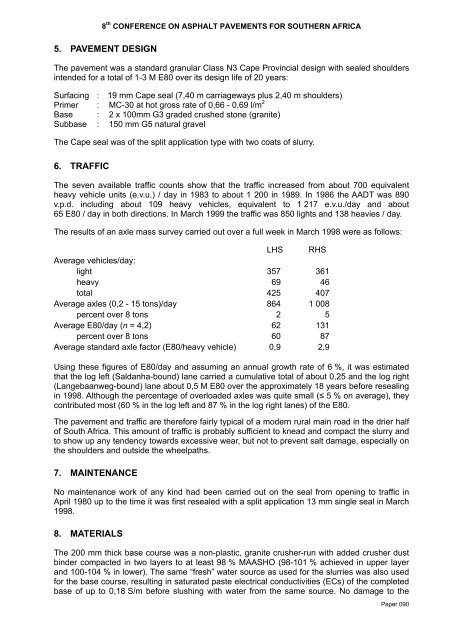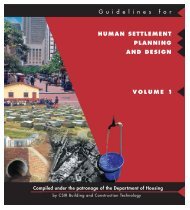8 th CONFERENCE ON ASPHALT PAVEMENTS FOR SOUTHERN AFRICA0061/298 8: Langebaanweg) (Table 1) suggests that Thornthwaite's Moisture Index (Schulze,1958) <strong>of</strong> about - 40 for the site (which is slightly less arid than Langebaanweg) gives a moreaccurate picture <strong>of</strong> the relatively arid nature <strong>of</strong> the area than does We<strong>in</strong>ert’s (1980) N-value <strong>of</strong> 4,which seems mislead<strong>in</strong>gly low. Most <strong>of</strong> the average <strong>of</strong> 274 mm <strong>of</strong> ra<strong>in</strong> falls dur<strong>in</strong>g the w<strong>in</strong>termonths <strong>of</strong> May to August and the least dur<strong>in</strong>g January to March. The mean annual A-panequivalent potential evaporation <strong>of</strong> about 2 200 mm after allowance for ra<strong>in</strong>fall is about eighttimes the mean annual ra<strong>in</strong>fall.The site therefore possesses the warm, dry climate conducive to salt damage (Netterberg,1979; Woodbridge et al, 1994).Climatic classificationThornthwaite (1931) (1)Table 1. Climatic data.Parameter Units Langebaanweg (0061/298 8)(Lat. 32° 58' S; Long. 18° 10' E)Thornthwaite’s Moisture Index (2)cmWe<strong>in</strong>ert’s N-value (3)-Mean annual ra<strong>in</strong>fall mm/y 274 (4); 265 (5)-Borderl<strong>in</strong>e Semiarid Warm (DB’d) to Arid Warm(EB’d), Moisture Deficient <strong>in</strong> All Seasons- 414Mean annual potential evaporation mm/y 2 200 (6)(1) From a 1:5M map by F. Netterberg (1969) (NITRR/<strong>CSIR</strong> Map No. RM1-77) after B.R. Schulze (1947).(2) From a 1:2,5M map by S.J. Emery (1992)(NITRR/<strong>CSIR</strong> Map No. 940-0-4184/4).(3) From a 1:5M map by H.H. We<strong>in</strong>ert (NITRR/<strong>CSIR</strong> Map No. RM1-59A/3.(4) Weather Bureau data for 1973 – 1998 (pers. comm.).(5) Weather Bureau (1986) data for 1973 – 1984.(6) Estimated Class A-pan (from Schulze et al, 1997).4. RAINFALLThe monthly ra<strong>in</strong>fall recorded at the site <strong>of</strong>fice dur<strong>in</strong>g the construction period <strong>of</strong> October 1979 –April 1984 compared well with the actuals and means for Langebaanweg. The actual ra<strong>in</strong>fallwas slightly less than the long-term average. The records for Langebaanweg show that thera<strong>in</strong>fall over the first few years (the critical period for salt damage) was normal. Thereafter (from1984 onwards) it was higher for a few years, but the average for the 18 years <strong>of</strong> 274 mm wasnormal.Both the total <strong>of</strong> 59 mm which fell at the site <strong>of</strong>fice dur<strong>in</strong>g the approximate period <strong>of</strong> constructionand the total <strong>of</strong> 201 mm for the year <strong>of</strong> October 1979 to September1980 were less than the longterm means for Langebaanweg <strong>of</strong> 79 and 254 mm, respectively. This means that the weatherdur<strong>in</strong>g construction and soon after open<strong>in</strong>g to traffic was more rather than less favourable thanaverage towards salt damage. In other words, the weather conditions under which theexperiment was laid were not unusual, and even apparently conservative.The total <strong>of</strong> 4 - 12 mm (S. V. 11,0 - 11,1 km) or 11-12 mm (S. V. 3,9 - 4,0 km) <strong>of</strong> ra<strong>in</strong> which fellbetween lay<strong>in</strong>g the bottom seawater slurries <strong>in</strong> Oct.-Nov. 1979 and cover<strong>in</strong>g them with the topslurry some 1 - 4 months later is considered to have been <strong>in</strong>sufficient to have leached any saltfrom the bottom slurries. However, the 22 mm which fell on the top seawater slurry betweenS. V. 3,896 and 4,015 km after lay<strong>in</strong>g on the 3 rd April and open<strong>in</strong>g to traffic on the 16 th April 1980might possibly have leached some salt out if it had not been well-rolled as soon as possible,especially as 13 mm fell the day after lay<strong>in</strong>g. The top slurries were apparently not rolled. Theperformance <strong>of</strong> the top seawater slurries may therefore have been slightly better than theywould have been had no ra<strong>in</strong> fallen. On the other hand, early leach<strong>in</strong>g out <strong>of</strong> salt might have leftvoids which would have tended to have had the opposite effect.Paper 090
8 th CONFERENCE ON ASPHALT PAVEMENTS FOR SOUTHERN AFRICA5. PAVEMENT DESIGNThe pavement was a standard granular Class N3 <strong>Cape</strong> Prov<strong>in</strong>cial design with sealed shoulders<strong>in</strong>tended for a total <strong>of</strong> 1-3 M E80 over its design life <strong>of</strong> 20 years:Surfac<strong>in</strong>g : 19 mm <strong>Cape</strong> seal (7,40 m carriageways plus 2,40 m shoulders)Primer : MC-30 at hot gross rate <strong>of</strong> 0,66 - 0,69 l/m 2Base : 2 x 100mm G3 graded crushed stone (granite)Subbase : 150 mm G5 natural gravelThe <strong>Cape</strong> seal was <strong>of</strong> the split application type with two coats <strong>of</strong> slurry.6. TRAFFICThe seven available traffic counts show that the traffic <strong>in</strong>creased from about 700 equivalentheavy vehicle units (e.v.u.) / day <strong>in</strong> 1983 to about 1 200 <strong>in</strong> 1989. In 1986 the AADT was 890v.p.d. <strong>in</strong>clud<strong>in</strong>g about 109 heavy vehicles, equivalent to 1 217 e.v.u./day and about65 E80 / day <strong>in</strong> both directions. In March 1999 the traffic was 850 lights and 138 heavies / day.The results <strong>of</strong> an axle mass survey carried out over a full week <strong>in</strong> March 1998 were as follows:LHS RHSAverage vehicles/day:light 357 361heavy 69 46total 425 407Average axles (0,2 - 15 tons)/day 864 1 008percent over 8 tons 2 5Average E80/day (n = 4,2) 62 131percent over 8 tons 60 87Average standard axle factor (E80/heavy vehicle) 0,9 2,9Us<strong>in</strong>g these figures <strong>of</strong> E80/day and assum<strong>in</strong>g an annual growth rate <strong>of</strong> 6 %, it was estimatedthat the log left (Saldanha-bound) lane carried a cumulative total <strong>of</strong> about 0,25 and the log right(Langebaanweg-bound) lane about 0,5 M E80 over the approximately 18 years before reseal<strong>in</strong>g<strong>in</strong> 1998. Although the percentage <strong>of</strong> overloaded axles was quite small (≤ 5 % on average), theycontributed most (60 % <strong>in</strong> the log left and 87 % <strong>in</strong> the log right lanes) <strong>of</strong> the E80.The pavement and traffic are therefore fairly typical <strong>of</strong> a modern rural ma<strong>in</strong> road <strong>in</strong> the drier half<strong>of</strong> South Africa. This amount <strong>of</strong> traffic is probably sufficient to knead and compact the slurry andto show up any tendency towards excessive wear, but not to prevent salt damage, especially onthe shoulders and outside the wheelpaths.7. MAINTENANCENo ma<strong>in</strong>tenance work <strong>of</strong> any k<strong>in</strong>d had been carried out on the seal from open<strong>in</strong>g to traffic <strong>in</strong>April 1980 up to the time it was first resealed with a split application 13 mm s<strong>in</strong>gle seal <strong>in</strong> March1998.8. MATERIALSThe 200 mm thick base course was a non-plastic, granite crusher-run with added crusher dustb<strong>in</strong>der compacted <strong>in</strong> two layers to at least 98 % MAASHO (98-101 % achieved <strong>in</strong> upper layerand 100-104 % <strong>in</strong> lower). The same “fresh” water source as used for the slurries was also usedfor the base course, result<strong>in</strong>g <strong>in</strong> saturated paste electrical conductivities (ECs) <strong>of</strong> the completedbase <strong>of</strong> up to 0,18 S/m before slush<strong>in</strong>g with water from the same source. No damage to thePaper 090
















